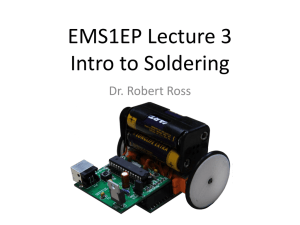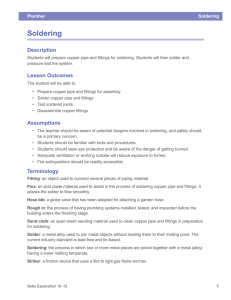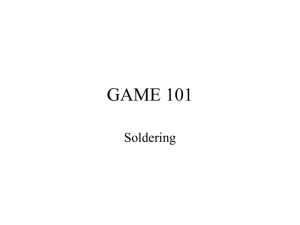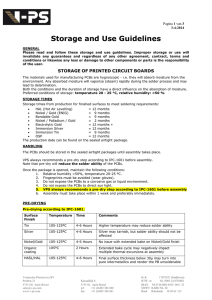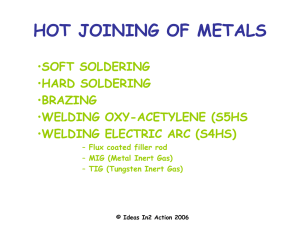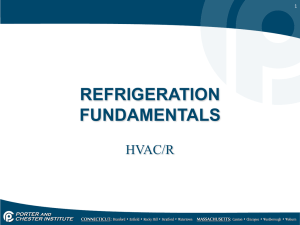Presentation 4 Soldering
advertisement
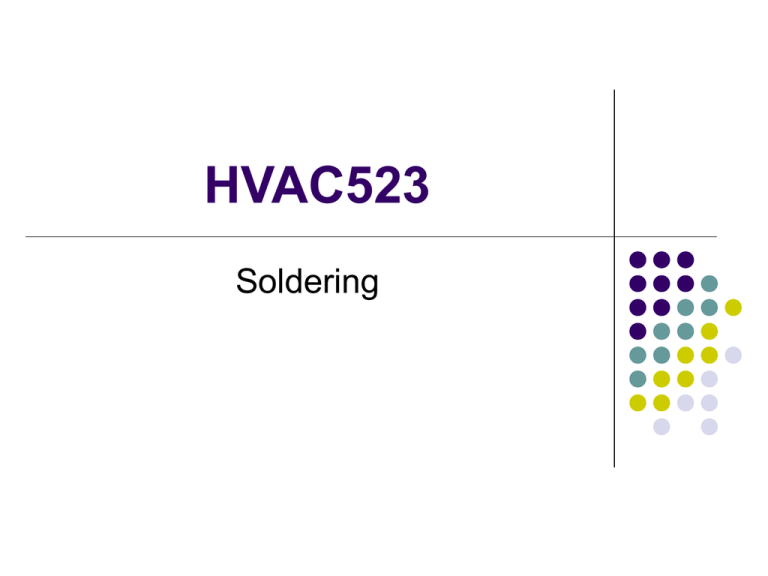
HVAC523 Soldering Soldering Copper Tubing The Common method of joining copper tubing in hydronic heating systems is soft soldering using a 95/5 (95 % tin/5 % antimony) solder. The maximum working pressure rating for of 95/5 solder is approximately 300psi. 95/5 solder The alloy content of all solders are listed in this area 95/5 melting range The melting temperature range for 95/5 solder is 452 – 464 degrees F. The narrow melting temperature range of 95/5 also means the joint will solidify very quickly when heat is removed. In other words, a fine balance of heating is needed when soldering. Proper Soldering Procedure Proper soldering results in clean, neat and water tight joints. Sloppy joints, even if water tight, indicate poor craftsmanship. With little practice, making good solder joints will become second nature. Soldering: step by step procedure Step 1. Be sure the tube is cut square, use a wheel cutter. Avoid using a hack saw whenever possible. Step 2. To remove any burrs, ream the end of the tube with the blade of the cutter wheel, rounded file or other type of de-burring tool Wheel cutter De-burring tool Soldering: step by step procedure Step 3. Assemble the joint and check it for proper fit and alignment. In most cases there will be no problem with the fit. However, sometimes a fitting may be damaged or defective. If the fitting wobbles noticeably on the pipe, it should be replaced. Soldering: step by step procedure Step 4. Clean the socket of the fitting with a properly sized fitting brush. Be sure to remove any pieces of the steel brush bristles remaining in the fitting after cleaning. These small pieces of steel can create galvanic corrosion that could eventually cause a leak in the fitting. Soldering: step by step procedure When cleaning a large amount of fittings, a cleaning brush can be adapted to fit in the chuck of a cordless drill. Cleaning brushes Hand cleaning brush Cleaning brush adapted to fit in a drill Soldering: step by step procedure Step 5. Clean the outside of the pipe with emery cloth. All oxidation, scale, dirt or paint should be removed from the tubing surface at least ½” inch further back than the edge of the fitting socket. The tube should appear bright following cleaning. Be sure to clean all the way around the perimeter of the pipe. Cleaning copper pipe Soldering: step by step procedure Step 6. Apply paste flux to the fitting socket and the portion of the pipe that fits inside the socket. The flux chemically cleans the surface of the copper and helps prevent oxidation of the surfaces when heat is applied. Always use a flux brush, not your fingers, to apply the flux. Do not apply excessive amounts of flux. Only a thin film is needed. Soldering: step by step procedure After fluxing, slide the tube into the fitting and, whenever possible, rotate the fitting once or twice to further spread the flux. Finally, wipe the excessive flux off with a clean rag prior to applying heat. Applying flux to the fitting and pipe Soldering: step by step procedure Step 7. Apply heat to the outside of the fitting socket using a torch. Keep the blue tip of the flame just above the surface of the socket. Move the tip of the torch around the fitting to promote even heating. Applying heat to a fitting Soldering: step by step procedure Heating times differ considerably with the type of torch and gas being used, as well as the pipe size, ambient temperature and type of solder. When the flux begins to sizzle or turn very clear, test the joint by applying the tip of the solder to the edge of the joint. . Soldering: step by step procedure If it sticks but does not melt apply more heat. If the solder immediately melts, the joint is ready to draw in the molten solder by capillary action Soldering: step by step procedure Once the solder begins to flow, it can be continually fed into the joint. Only a small amount of solder is needed. An experienced pipe fitter knows by sight how much solder to feed into a joint. An inexperienced person often feeds excessive solder into the joint. Soldering: step by step procedure The excessive solder can solidify into small loose particles inside the pipe. These can be carried around the system by the fast moving fluid and become lodged in valves or circulators. A good rule of thumb is to use an approximate length of solder that is equal to the diameter of the pipe. Soldering: step by step procedure Step 8. After the solder is applied, remove the torch and if necessary, carefully wipe the perimeter of the joint with a clean cloth to remove any excess solder or flux. The joint should be allowed be allowed to cool naturally before being handled or stressed. Soldering: step by step procedure After the joint has cooled, one last wipe of the pipe with a damp rag will remove any remaining flux This is an important step because flux residue left on the joint eventually causes unsightly surface oxidation. Soldering: step by step procedure Be a professional and always clean every joint Additional Soldering Tips Its best to make up piping assemblies on a horizontal working surface. The solder flow is more controllable When soldering has to take place next to combustible material, place a noncombustible material, such as sheet metal, between the torch and the material you are protecting. Additional Soldering Tips Measure all tubing carefully before cutting. Allow for the amount of pipe that fill fit into the fitting socket. Additional Soldering Tips Whenever possible, attempt to keep all piping plumb. (Vertically and horizontally) Install temporary piping support if necessary to hold the pipe in proper alignment for soldering. Additional Soldering Tips When soldering valves, open the valve to allow for the heat to dissipate out of the valve as to not damage it. This is especially true for zone valves. Always read the installation instructions from the manufacturer of the valve. Additional Soldering Tips On fittings that have both soldered and threaded fittings, make up the soldered joint first. This prevents discoloration or burning of Teflon tape or joint compound during soldering Additional Soldering Tips Always keep one end of the pipe open when soldering. If this is not done, pressure can build up in the pipe due the heat and cause pinholes to form in the solder. Additional Soldering Tips Finally, take a few extra minutes to clean up excessive flux and solder. Your customers will notice it!
